January 3, 2010 Update:
While this was written originally 11 years ago, tragically, little has
changed. All the Dineh were not relocated by the February 2000
deadline. A small core population of mostly elders remain and they are
harassed daily. Please never forget these people who fight to
retain their home on a daily basis and if what you read angers and
inflames you, seek out the organizations that are trying to help and
support them in any way you can. And never forget that the US, the
"land of the free," still has subjugated and abused populations, a
tragic, continuing legacy of the atrocities that formed this nation. NOTE REGARDING LINKS
Some of the websites in the commentary Resource links may no
longer exist, but most can still be found with the help of the Internet
Archive. If you are unable to find a site, go to http://www.archive.org
and enter the link address. The Archive keeps a copy of most files
from the entire Internet since 1996.
May 3, 1999
Mining - the Navajo - to Extinction
Resource Extraction and The Genocide of the Navajo
People
See Part 2 of the story of
this crisis: How
The West Was Lost
(this is an expanded
version of the article that is posted on the Environment News Service)
By Jackie Alan Giuliano, Ph.D.
We the five-fingered beings are related
to the four-legged,
the winged beings, the spiritual beings, Father Sky, Mother
Earth, and nature.
We are all relatives. We cannot
leave our relatives behind.
Betty Tso, traditional Navajo
In our traditional tongue, there is no
word for relocation.
To relocate is to move away and disappear.
Pauline Whitesinger, Big Mountain Elder
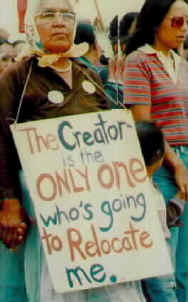
With all the talk of alternative fuel
sources and energy-efficient light bulbs you hear today, 55 percent
of our nation's electricity is still generated by the burning of coal.
This requires that tens of millions of tons of coal be extracted from
the Earth each year. The toxic fallout from coal burning is well known
to most, but largely unknown is that the price being paid for extracting
this coal is the virtual genocide of approximately 10,000 Navajo people.
Environmentalists, politicians, scholars, new age speakers and theologians
will often speak of the power and wisdom of the native peoples of
North America. Their reverence for life, connection to the Earth and
appreciation of the web of life are foundational concepts in many
philosophies. The modern day environmental movement began with these
philosophies at its core. Yet while many non-Native American people
speak of that wisdom from
comfortable settings, the United States government continues to implement
its final solution for the last remaining original inhabitants of
this land. All native peoples have been suffering but the Navajo in
particular face an ominous deadline. 
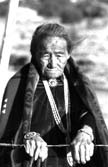 By
February 2000, the U.S. government plans to complete the relocation
of the Navajo, known as Dineh in their native tongue, that remain
at a site in Arizona that they have inhabited since the U.S. Army
tried to wipe them all out in 1863. The relocation site is a desolate
piece of land downstream from the location of the nation's worst nuclear
waste disaster in 1979 and is unfit for humans or animals. This relocation
began by order of President Ford in 1974, when he signed Public Law
93531 while on a skiing trip. Nearly 12,000 Dineh have been forcibly
moved from their tribal land since then and the impacts have been
catastrophic for their people. By
February 2000, the U.S. government plans to complete the relocation
of the Navajo, known as Dineh in their native tongue, that remain
at a site in Arizona that they have inhabited since the U.S. Army
tried to wipe them all out in 1863. The relocation site is a desolate
piece of land downstream from the location of the nation's worst nuclear
waste disaster in 1979 and is unfit for humans or animals. This relocation
began by order of President Ford in 1974, when he signed Public Law
93531 while on a skiing trip. Nearly 12,000 Dineh have been forcibly
moved from their tribal land since then and the impacts have been
catastrophic for their people.
 Twenty
five percent of the first group that was moved in 1980 died within
6 years of arrival on the new site. Since then, the remaining population
is ravaged by birth defects from the uranium mine waste spill in 1979
and by deep cultural wounds. The native plants vital to the religious
ceremonies of the Dineh do not grow at the relocation site. Their
animals die from radiation poisoning. Their bond with Mother Earth,
they believe, has been broken. To the Dineh, to relocate from the
land of their birth is to disappear. Twenty
five percent of the first group that was moved in 1980 died within
6 years of arrival on the new site. Since then, the remaining population
is ravaged by birth defects from the uranium mine waste spill in 1979
and by deep cultural wounds. The native plants vital to the religious
ceremonies of the Dineh do not grow at the relocation site. Their
animals die from radiation poisoning. Their bond with Mother Earth,
they believe, has been broken. To the Dineh, to relocate from the
land of their birth is to disappear.
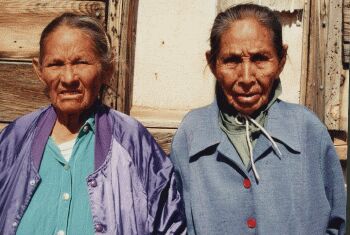 Those
that have refused relocation are mostly elders. The U.S. government
is now taking extreme measures to force them from their homes. Those
that have refused relocation are mostly elders. The U.S. government
is now taking extreme measures to force them from their homes.
This relocation is the result of the same plague that is destroying
us all from the inside out - the endless extraction of resources from
the Earth and the greed of those that control the money, property
and power in this country. The Native American reservations, those
marginal lands that were given to the remaining Indians as a settlement
when the U.S. expanded into the West and stole their land, contain
considerable mineral resources, particularly coal. 
The U.S. wants the Dineh out of the area around Big Mountain, Arizona,
the site of a massive coal strip mine operated by the Peabody Western
Coal 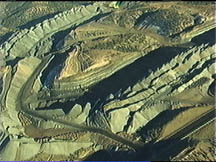 Company.
In the 1940's and 1950's, it was discovered that massive deposits
of coal, oil and uranium lay beneath the lands that the Dineh settled
in after the U.S. Army, led by Colonel Kit Carson in 1863, began its
efforts to kill everyone in the Dineh nation. Thousands of Dineh were
killed during that assault and thousands more were forced to march
400 miles in the infamous "Long Walk" during the winter. Some escaped
and took refuge in the Black Mountain region. Those who survived the
five years of imprisonment rejoined their people there. Company.
In the 1940's and 1950's, it was discovered that massive deposits
of coal, oil and uranium lay beneath the lands that the Dineh settled
in after the U.S. Army, led by Colonel Kit Carson in 1863, began its
efforts to kill everyone in the Dineh nation. Thousands of Dineh were
killed during that assault and thousands more were forced to march
400 miles in the infamous "Long Walk" during the winter. Some escaped
and took refuge in the Black Mountain region. Those who survived the
five years of imprisonment rejoined their people there.

The U.S. hunger for the resources on the Dineh and Hopi lands was
insatiable. The mineral companies sought agreements with the Tribal
Councils set up by the U.S. government to expedite the awarding of
mineral rights to companies. Most Dineh still do not know how to read
and write English and few have any connection with the decisions of
these Tribal Councils. The result has been that one-third of all uranium
mined in the U.S. has come from Dineh land and the world's largest
strip mine was erected in the 1960's to mine coal. The nation's largest
power plant was built adjacent to the site, generating so much pollution
from the burning of coal that Apollo astronauts saw the toxic clouds
it emanates from the Moon. It is the largest single point source of
greenhouse gasses in North America. Many Native Americans who worked
in the uranium mines have suffered from radiation sickness and many
children suffer from birth defects.
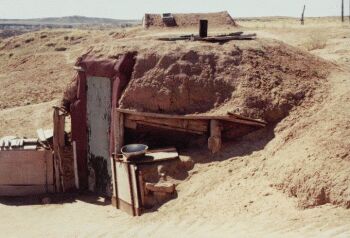 About
3000 Dineh have resisted eviction from the area for the last 25 years.
In 1996, President Clinton, while on a golfing vacation, signed Public
Law 104-301 sanctioning the forced evictions of the remaining Dineh
by February, 2000. In an effort to force out those that remain on
the land, a U.S. court ordered that the Dineh cannot repair their
homes or build new ones, denied them access to fresh water, and confiscated
their livestock upon which they depend. Firewood is confiscated in
winter, and law enforcement officials harass and threaten them with
eviction and jail sentences. This level of harassment and violation
of basic human rights would never be tolerated in any U.S. city. About
3000 Dineh have resisted eviction from the area for the last 25 years.
In 1996, President Clinton, while on a golfing vacation, signed Public
Law 104-301 sanctioning the forced evictions of the remaining Dineh
by February, 2000. In an effort to force out those that remain on
the land, a U.S. court ordered that the Dineh cannot repair their
homes or build new ones, denied them access to fresh water, and confiscated
their livestock upon which they depend. Firewood is confiscated in
winter, and law enforcement officials harass and threaten them with
eviction and jail sentences. This level of harassment and violation
of basic human rights would never be tolerated in any U.S. city.

The Peabody Western Coal Company is owned by Hanson Holding Company
of London, England. They have paid the Navajo and Hopi Tribal councils
12 cents per ton of coal, which they sell for $22 per ton in the marketplace.
They mine 12 million tons of coal per year.
 
Currently, the Bureau of Indian Affairs has begun confiscating the
livestock of those who refuse to sign a lease saying they can live
on the land for 75 years. At the end of that lease, ownership would
be taken away for all time. The people being affected by these confiscations
are all elderly people who rely on the animals for their lives. Taking
their livestock is tantamount to issuing a death sentence.
These government sponsored flagrant civil and human rights abuses
are inexcusable. Congress and the President must be told that the
American people will not tolerate this kind of behavior.
Of course, we must remember that the insane push to extract resources
from the Earth at all costs is due to the demands that business, industry
and we as individuals make. If we dramatically reduce our energy needs
and dependence, then the need to extract resources would diminish
as well.
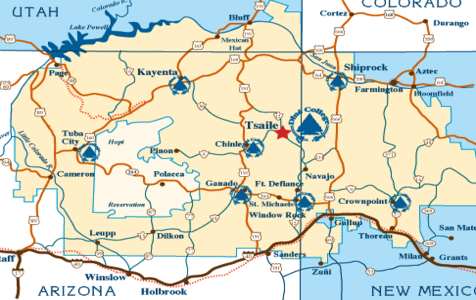 We
all must send letters of support (and financial contributions if you
can). The Resources section below will tell you how. The United States
was built on a legacy of murder and abuse of the original inhabitants
of this land. We cannot carry that legacy into the future and begin
the new millennium with more blood on our hands. We
all must send letters of support (and financial contributions if you
can). The Resources section below will tell you how. The United States
was built on a legacy of murder and abuse of the original inhabitants
of this land. We cannot carry that legacy into the future and begin
the new millennium with more blood on our hands.

RESOURCES
Please write letters (email, regular mail or FAX) to your elected
representatives to urge them to stop the genocide of the Dineh and
give them the rights they deserve. This 25-year tragedy must end now.
The resources below will help you take action.
-
For updated status reports on actions against the Dineh and how
you can help, visit www.blackmesais.org
-
For a prepared letter that you can copy and send to your elected
representatives visit http://www.magiccookie.com/activism/black-mesa/scia-19990219.html.
It has a list of the current U.S. Senators who sit on the Select
Committee on Indian Affairs.
-
The Dineh resistance effort needs money. Tax deductible donations
can be sent to their authorized agent below. I have worked with
these people personally for many years and I can assure you that
the money will reach its destination. They also have a video that
presents the issue:
Social and Environmental Entrepreneurs (SEE), 20110 Rockport Way,
Malibu, CA, 90265-5340,
Telephone: (310) 456-3534.
Please make your check payable to Sovereign Dineh Nation (SDN).
Call them first to make sure the program is still going
-
If you or anyone you know could possibly go to Black Mesa and
stand by the elders during this struggle, you can contact them
at: Black Mesa Indigenous Support, (520)773-8086, P.O. Box 23501,
Flagstaff, AZ 86002. Email fbmsn@hotmail.com
or granmonta@hotmail.com
-
Send letters to the following officials.
Email the Bureau of Indian Affairs at nedra_darling@ios.doi.gov
Fred Chavez, Bureau of Indian Affairs, Hopi Agency, P O Box
158, Keams Canyon, AZ. 86034
Kevin Gover, Assistant Secretary, Indian Affairs, Bureau of Indian
Affairs, kevin_gover@ios.doi.gov,
Office: 202-208-3711, Fax: 202-501-1516
for a complete BIA phone book, visit http://www.doi.gov/bia/biapho.htm
-
For a detailed list of addresses of those who need to hear from
you, visit http://www.magiccookie.com/activism/black-mesa/contacts.html.
The site is still under construction, but a lot of good information
is there now.
-
See a thorough summary of the history of the Dineh relocation
at http://www.alphacdc.com/wsdp/dine-ct.html
-
Another good summary can be found at http://www.umc-gbcs.org/dineh-am.htm
which focuses on the human rights violations and the religious
freedoms issue.
-
Read the EPA description of the Church Rock nuclear waste spill
superfund site that is upstream from the relocation site. Ten
thousand Dineh are living and suffering here now. You must have
Adobe Acrobat Reader installed to read http://www.epa.gov/earth1r6/6sf/pdffiles/unitdnuc.pdf
-
Send an email message to President Obama at president@whitehouse.gov
demanding action on this issue. The Dineh must be supported and
the harassment being condoned by the U.S. government in the interest
of big business must end.
-
Find out who your Congressional representatives are and e-mail
them. Demand that the harassment of the Dineh end and that steps
be taken to help these people that the U.S. has persecuted since
its beginning. If you know your Zip code, you can find them at
http://www.visi.com/juan/congress/ziptoit.html
- Learn about the issues. A great alternative bookstore is Powell’s
Bookstore in Portland, Oregon at http://www.powells.com/cgi-bin/associate?assoc_id=212
where you will find a wonderful alternative to the massive chain
bookstores taking over the market.
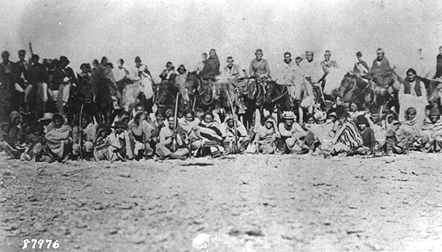
Navajo Prisoners in 1863, on the Long Walk (from
the National Archives (http://www3.pbs.org/weta/thewest/wpages/wpgs640/64_07.htm)
{Jackie Giuliano, a writer and teacher in Seattle, WA. Please send your thoughts, comments,
and visions to him at jackie@healingourworld.com
and visit his web site at www.healingourworld.org}
|
